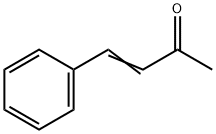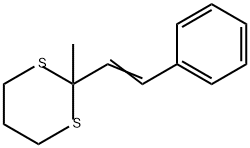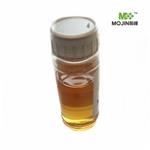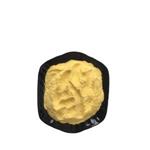Flavorants
Our GB2760-1996 provisions temporarily allow benzalacetone as a food spice, it is used to modulate sweet pea, cocoa, nuts, cherries, fruit flavor aroma, also used as floral flavor variable swap and anti-propellant, because of the stimulating effect on the skin, it is generally not used in cosmetics. Also benzalacetone can also be used as a mordant, fixing agent and preparation galvanized credit agent in dyeing industry. Credit agent is an organic compound capable of producing bright and leveling effect. Usually it contains aromatic aldehydes or ketones and certain heterocyclic aromatic aldehydes, ie coumarin, vanillin, benzalacetone, its molecular structure contains a carbonyl group, just keeps this structure intact, substituting various substituents, it can produce many kinds of compounds having light effects. Among these, benzalacetone displays best effects, domestic commercial additives are mostly based on such benzalacetone predominating brightener. The most commonly used method is based on the preparation of benzaldehyde and acetone as raw materials, to carry out the Claisen reaction, in the presence of a base (sodium hydroxide or sodium carbonate), aldehydes and ketones condensate, after completing the reaction, diluted hydrochloric acid is added and adjusted to pH = 6-7, set still for stratification, the upper yellow oil is separated, in order to maximize the yield, the lower layer is extracted with benzene, the extract is dried after recovery of benzene, and the oil is combined, then washed with water, separate the oil , bleached with activated carbon, filtered, and purified by vacuum steam distillation, cooled and crystallized, to get crude benzalacetone .
Benzalacetone is also known as 4-phenyl-3-butene-2-one, dibenzylideneacetone, cinnamyl methyl ketone, benzal acetone, methyl styryl ketone. The product abtained by vacuum distillation system is colorless to pale yellow shiny lamellae. It owns sweet pea fragrance and spicy and pungent flavor, changes to deep color exposed in light, combustible, prolonged heat leading to decomposition. Naturally it presents in hydrolyzed soy protein. The formations include cis and trans. Relative molecular mass is 146.19. The relative density is 1.0076 (47.3 ℃). The freezing point is 39 ℃, the melting point is 42 ℃. The boiling point is 261 ℃, 211 ℃ (26.664 × 103Pa), 187.8 ℃ (13.332 × 103Pa), 161.3 ℃ (5.333 × 103Pa), 143.8 ℃ (2.666 × 103Pa), 127.4 ℃ (1.333 × 103Pa), 112.2 ℃ (0.666 × 103Pa ), 81.7 ℃ (0.133 × 103Pa). The refractive index is 1.5836 (45.9 ℃). It is slightly soluble in water and petroleum ether, slightly soluble in benzene, soluble in ethanol, benzene, ether, chloroform and sulfuric acid. It displays a reddish color while reacting with sulfuric acid, this feature can be used to detect the product.
The above information is edited by the Chemicalbook of Tian Ye.
Toxicity
LD50 orally in Rabbit: 2031 mg/kg
Application limitation
FEMA (mg/kg): Soft drinks 0.82 ; cold drinks 0.84; confectionery 3.7; bakery 4.5;jelly and pudding 2.1 ; shortening 0.20.
Chemical Properties
It is colorless crystals. It has a coumarin odor. It is soluble in alcohol, ether, benzene and chloroform, slightly soluble in water and petroleum ether.
Uses
1. It is used for the preparation of spices and galvanized brightener.
2. GB 2760--1996 allows it used as food with spices. Formulated balm, cherries, grapes, berries, anise-based and other flavors for temporary .
3. This product is used as galvanized additives, coating materials to increase the brightness. The dyeing industry uses it as a mordant in dyeing agent to improve the uniformity and firmness, also it can be used for the preparation of spices and flavoring agents.
4. 4-phenyl-butene (3)one-2 is one rodenticide warfarin intermediates.
5. As an aromatic organic substance, it is the most widely superior light additive in acid zinc plating process , in the potassium chloride, ammonium plating process, it can get bright coating in a very wide current density and the temperature range, play a good effect on the coating of the internal stress, anti-corrosion ability. This product is also available anti volatile agent for spices, mordant and fixing agent in dyeing industry, it can also be used to prepare spices flavoring agent.
6. Organic synthesis intermediates. It can be used as a spice anti propellant. In dyeing industry,it is used as mordant , fixing agent, it is used for the preparation of spices or flavoring agents, and preparation for galvanized credit agent.
Production method
Using Benzaldehyde for raw materials, and carrying out condensation reaction with acetone . Benzaldehyde and acetone, mixed with water, cooled slowly, added 10% sodium hydroxide solution, the temperature controlled at 25-31°C, After the addition, the stirring was continued for 1h. Then diluted hydrochloric acid was added to pH 6-7, set still for 1h, isolated as a yellow oil. Lower layer was extracted with benzene, the extract and oil were combined, washed twice with water, after the separation the layer of water, recovered benzene, and then dried over calcium chloride, dry decolorizing charcoal was added , filtered and the filtrate vacuum distillation derived products. . Fixed material consumption : benzaldehyde 1700kg/t, acetone 2900kg/t, caustic soda (40%) 500kg/t.
Chemical Properties
4-Phenyl-3-buten-2-one has a sweet, floral, creamy, pungent odor reminiscent of coumarin and rhubarb with a sweet,
pungent flavor. It is not very stable.
Chemical Properties
Yellow Solid
Occurrence
Occasionally Benzalacetone is used in perfumery for Sweet Pea (used to be a “must” in this type of fragrance), in Appleblossom, etc., often in combination with Neroli and Hyacinth bases. Also used in flavors, particularly in Chocolate, Cocoa, Cherry, Fruit, Nut, Vanilla, etc. - but usually at very low concentration. Concentration in finished product will rarely exceed 0.2 to 0.5 ppm.
Uses
In perfumery, organic syntheses.
Uses
Benzylideneacetone is used chiefly as a scent in the manufacture of perfume, drugs & electroplating.
Uses
brightener in acid zinc electroplating,also used as an organic synthesis intermediate in flavor and fragrance, pharmaceutical industries
Preparation
By condensing benzaldehyde and acetone in the presence of an alkaline condensing agent.
Definition
ChEBI: Trans-benzylideneacetone is the trans-isomer of benzylideneacetone. It acts as an inhibitor of the enzyme phospholipase A2 (EC 3.1.1.4) of insects like diamond back moth. It has a role as a flavouring agent, a fragrance, a bacterial metabolite and an EC 3.1.1.4 (phospholipase A2) inhibitor.
Application
Benzalacetone is an endogenous metabolite. It acts as a flavouring agent, a spice, a bacterial metabolite and an inhibitor of EC 3.1.1.4 (phospholipase A2). It is mainly used in food additives, flavours and fragrances, and as an intermediate in chemical synthesis or reaction reagents. In addition, the novel hydrophobic benzazepine acetone can also be used to modify lead dioxide electrodes for electrocatalytic degradation of coal tar wastewater.
Reactions
Benzalacetone can be utilized for catalytic hydrogenation to yield alcohols, employing Raney nickel as the catalyst. Research has demonstrated that in the presence of HCl and H3PO4, Raney nickel experiences a loss of catalytic activity, resulting in a decreased hydrogenation rate; conversely, NaCl does not exert any significant effect. Although the hydrogenation of the ethylene bond in benzalacetone is inhibited, it is primarily the reduction in hydrogen absorption by the carbonyl group that is more significantly impacted, leading to a marked decrease in the quantity of alcohol produced.
[1]
Aroma threshold values
Aroma characteristics at 1.0%: sweet, fruity and jamy cherry-like, aldehydic cinnamon spicy, herbal,
anisic, balsamic, toasted almond nutty and woody with slight powdery vanilla nuances.
Taste threshold values
Taste characteristics at 5 to 10 ppm: aldehydic, coumarinic and balsamic, slightly nutty, floral and fruity
with woody nuances.
General Description
trans- 4-Phenyl-3-buten-2-one is substrate for glutathione transferase. It reacts with methyl- and benzylguanidine to yield aromatic
N2-substituted 2-pyrimidinamines.
Safety Profile
Poison by intravenous route. Moderately toxic by intraperitoneal route. A skin irritant. A flammable liquid. When heated to decomposition it emits acrid smoke and irritating fumes. See also KETONES.
Purification Methods
Crystallise it from pet ether (b 40-60o), or distil it (b 137-142o /16mm). [Beilstein 7 IV 1003.]
References
[1] Y. ABDOH; M. R D. Selective hydrogenation of benzalacetone[C]//17 9. 1967: 256-257. DOI:10.1002/jctb.5010170904.





